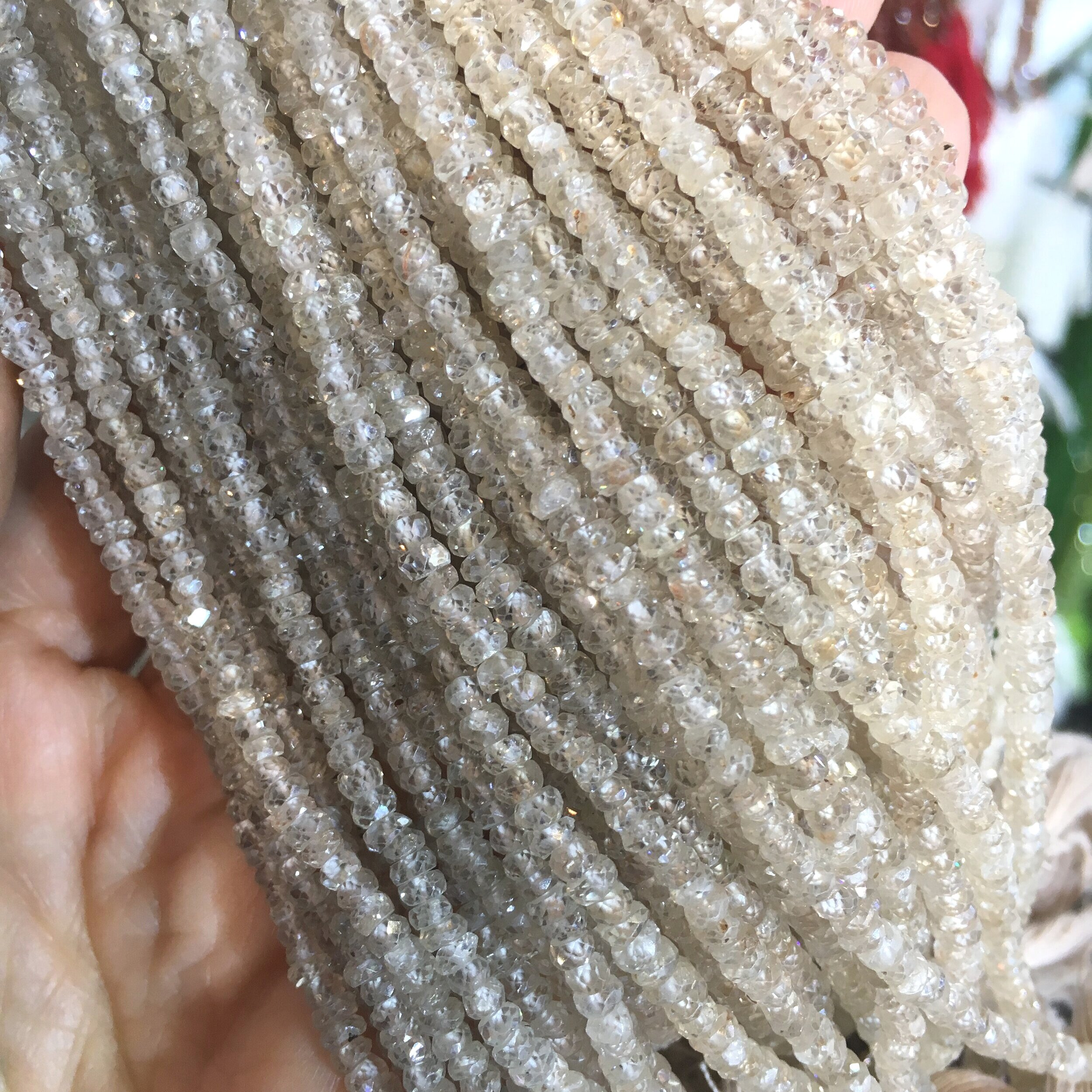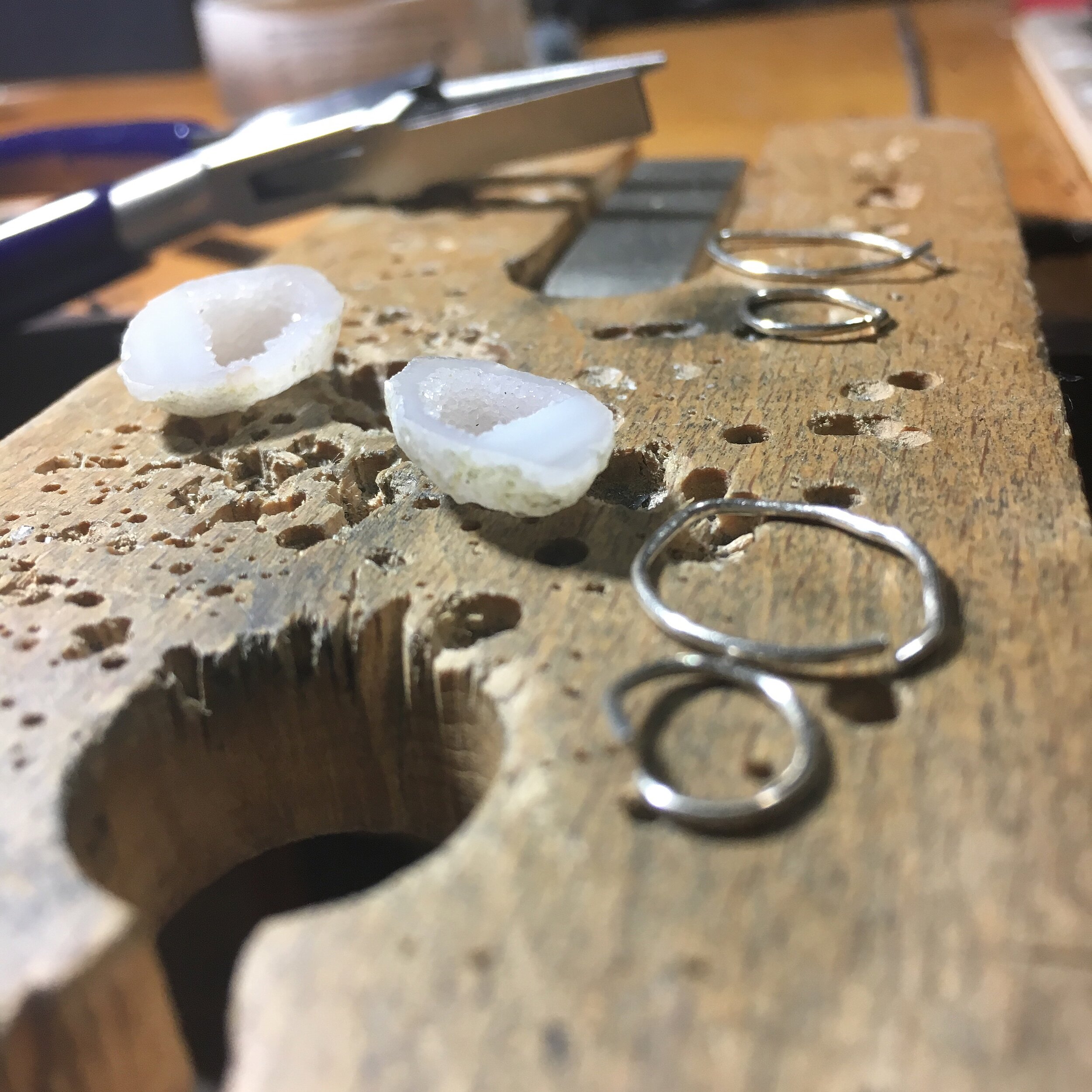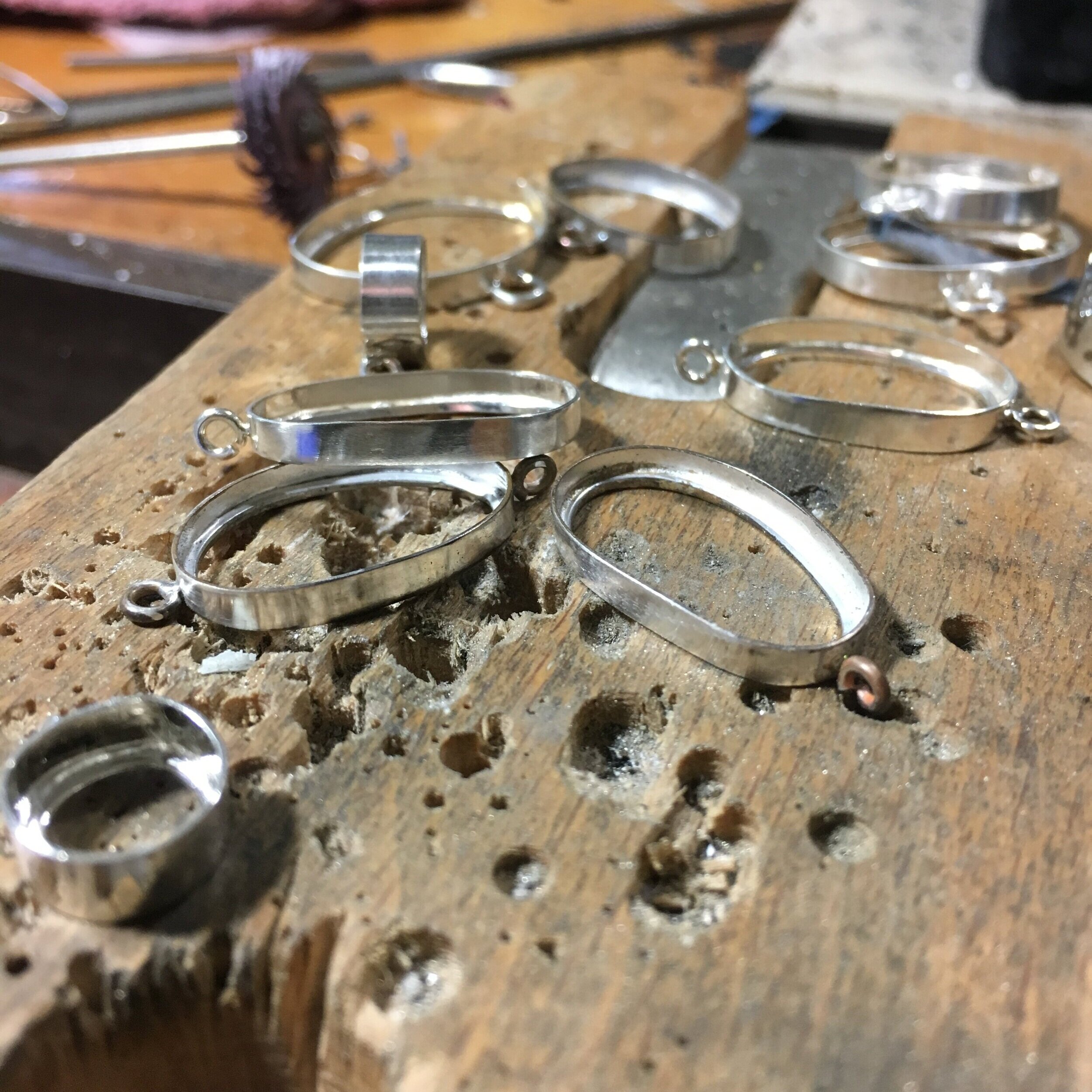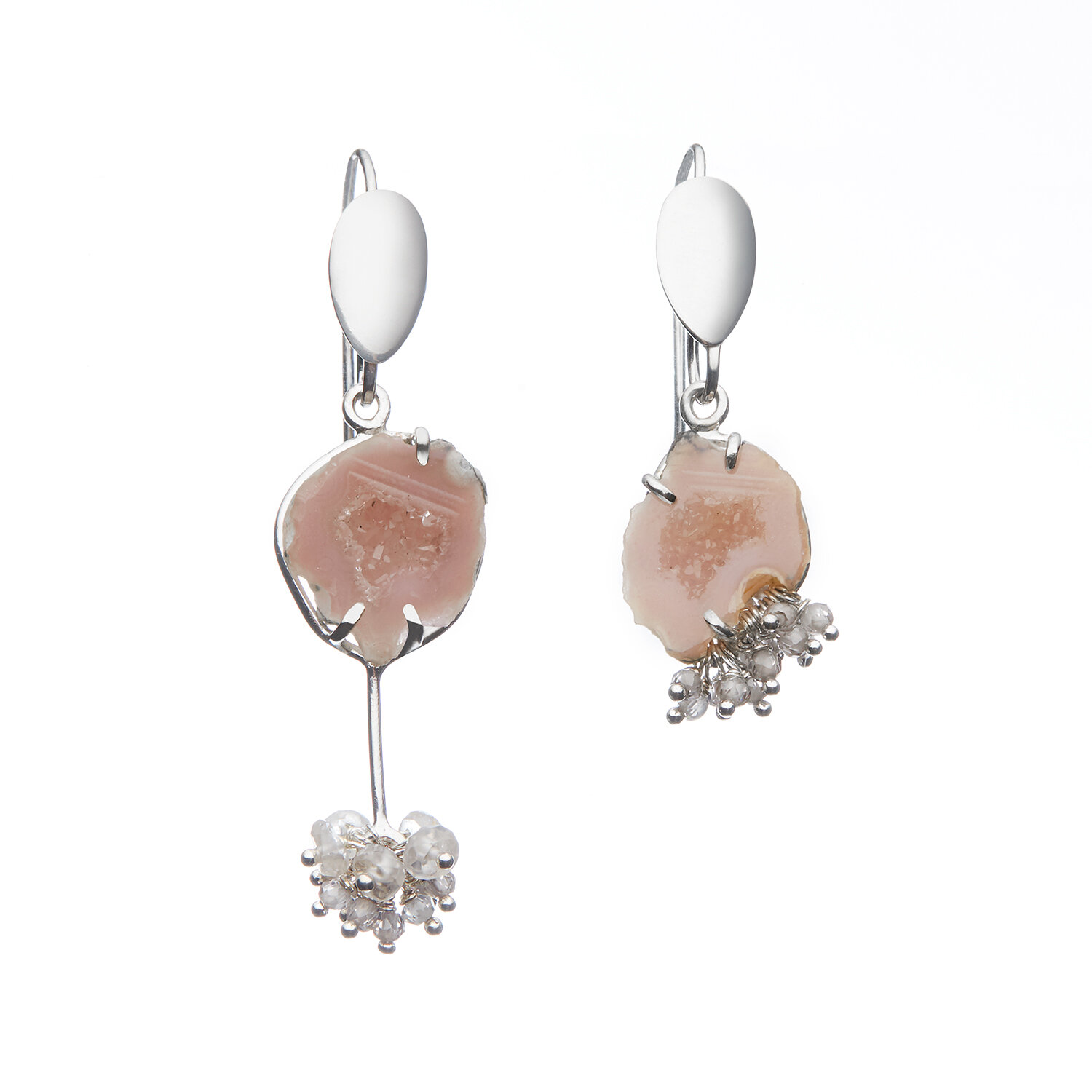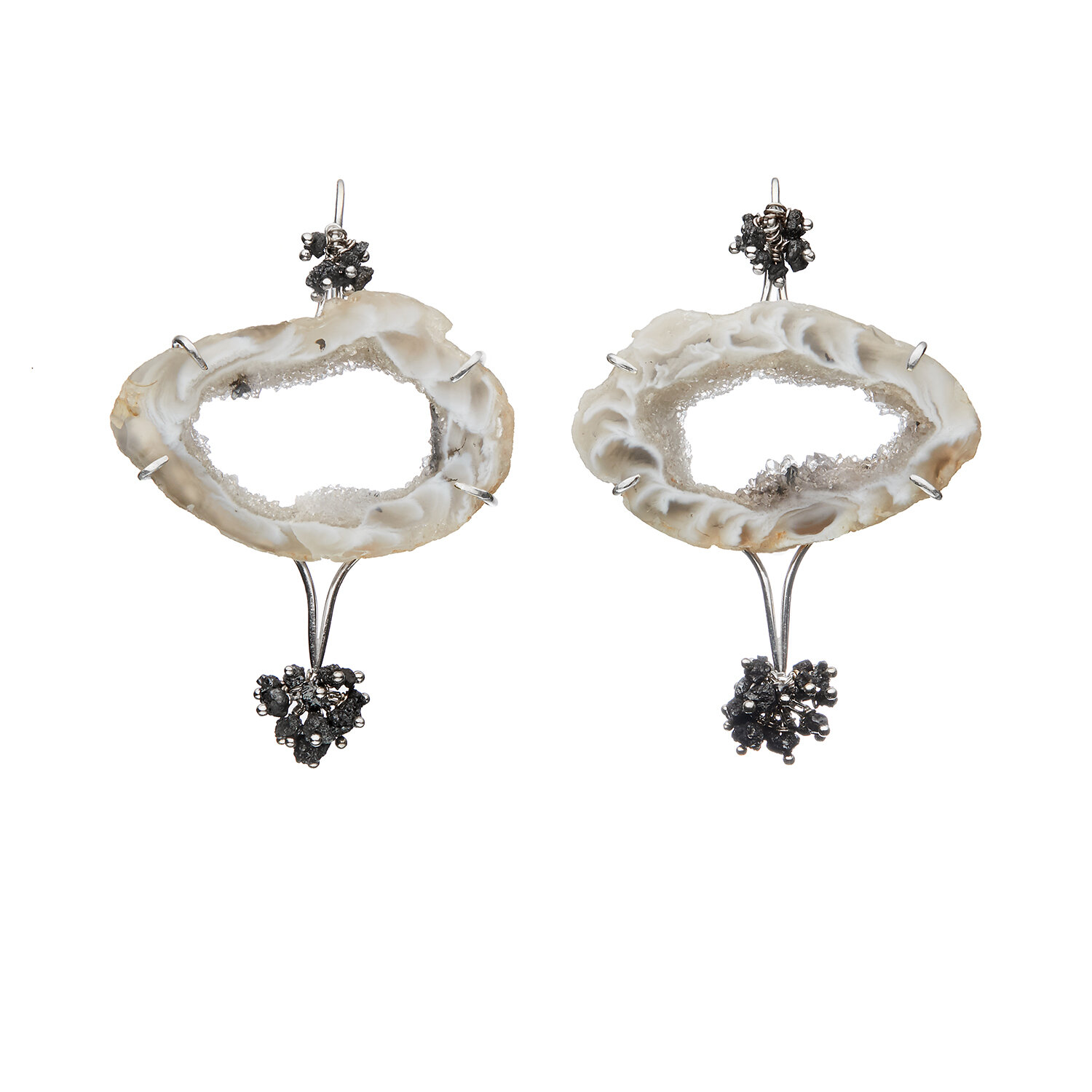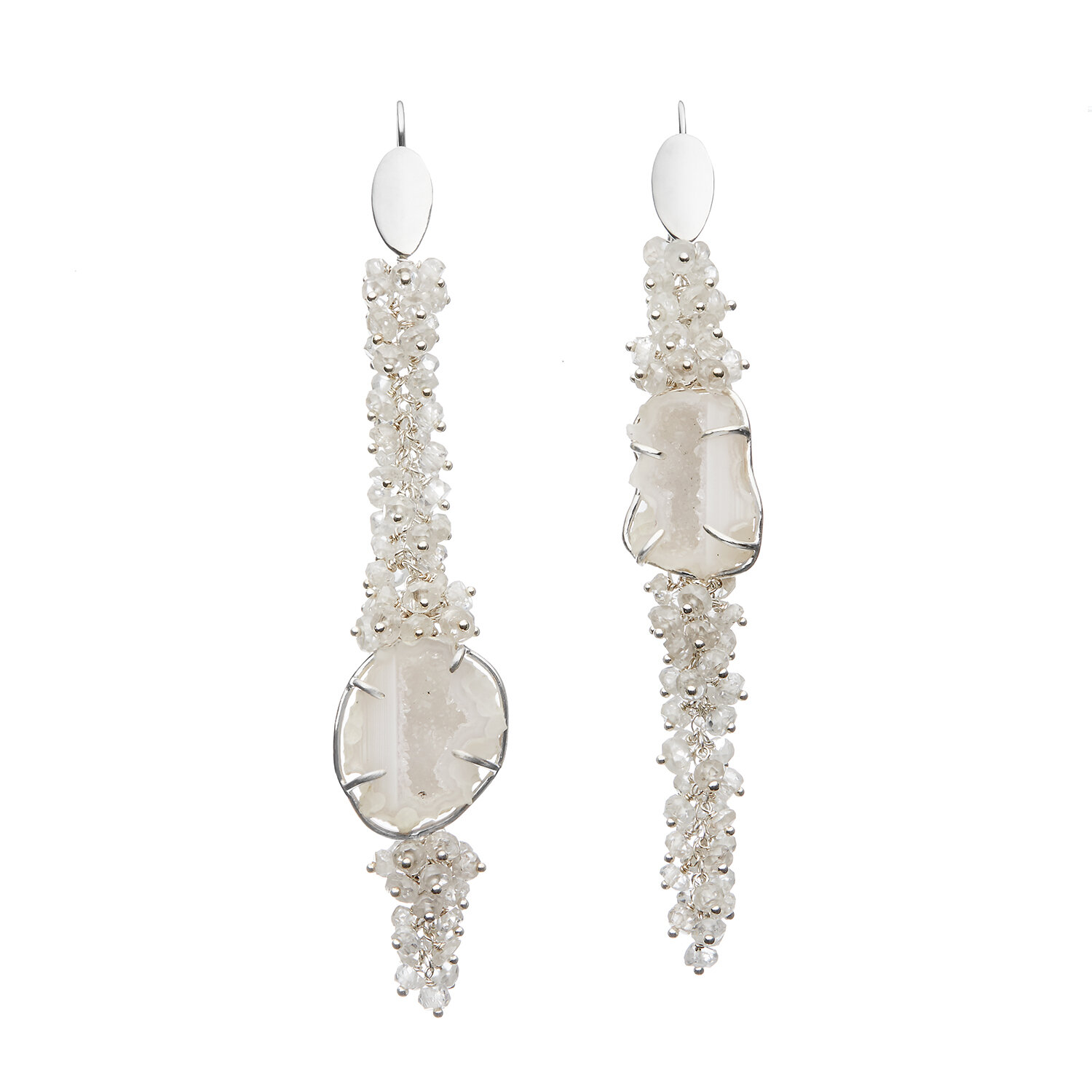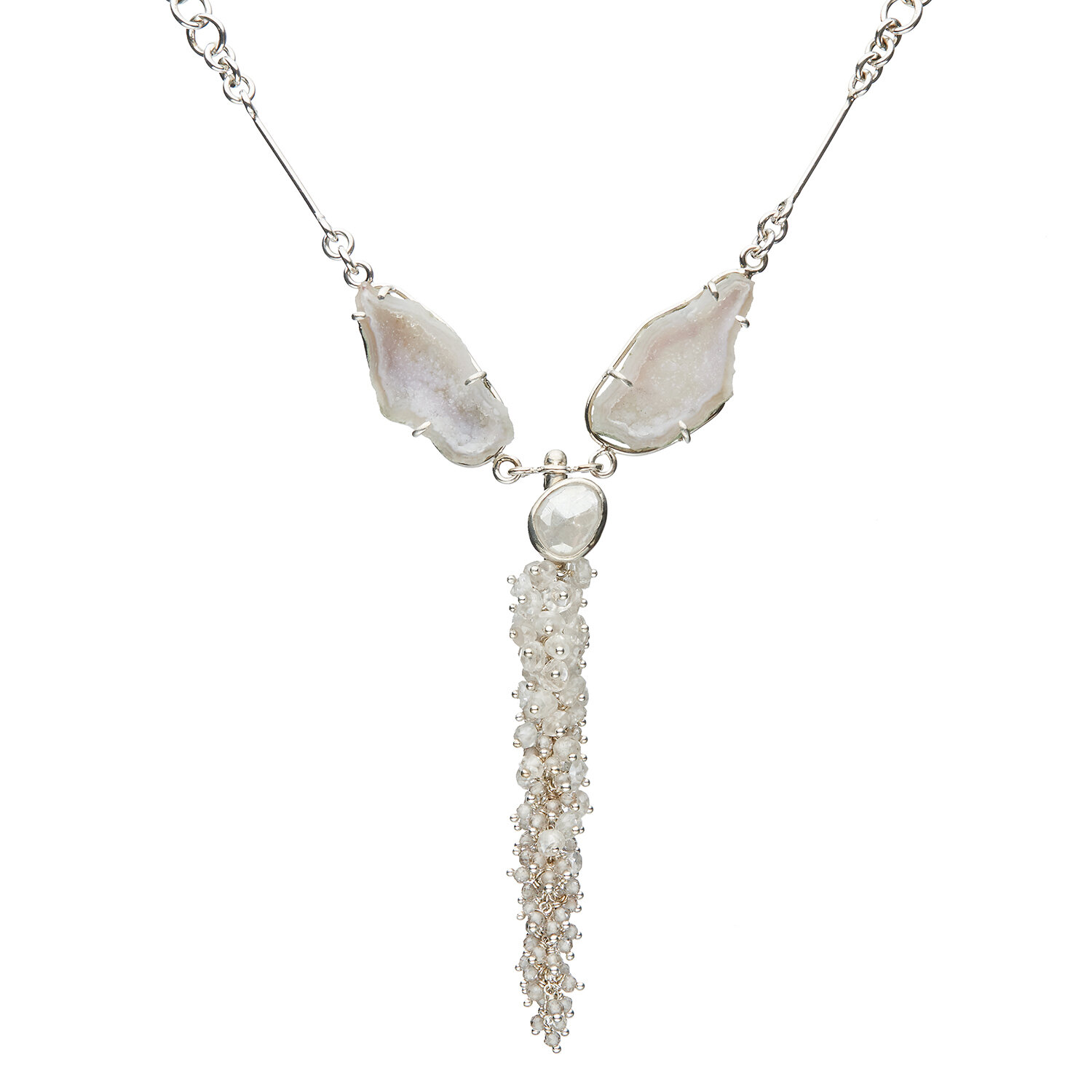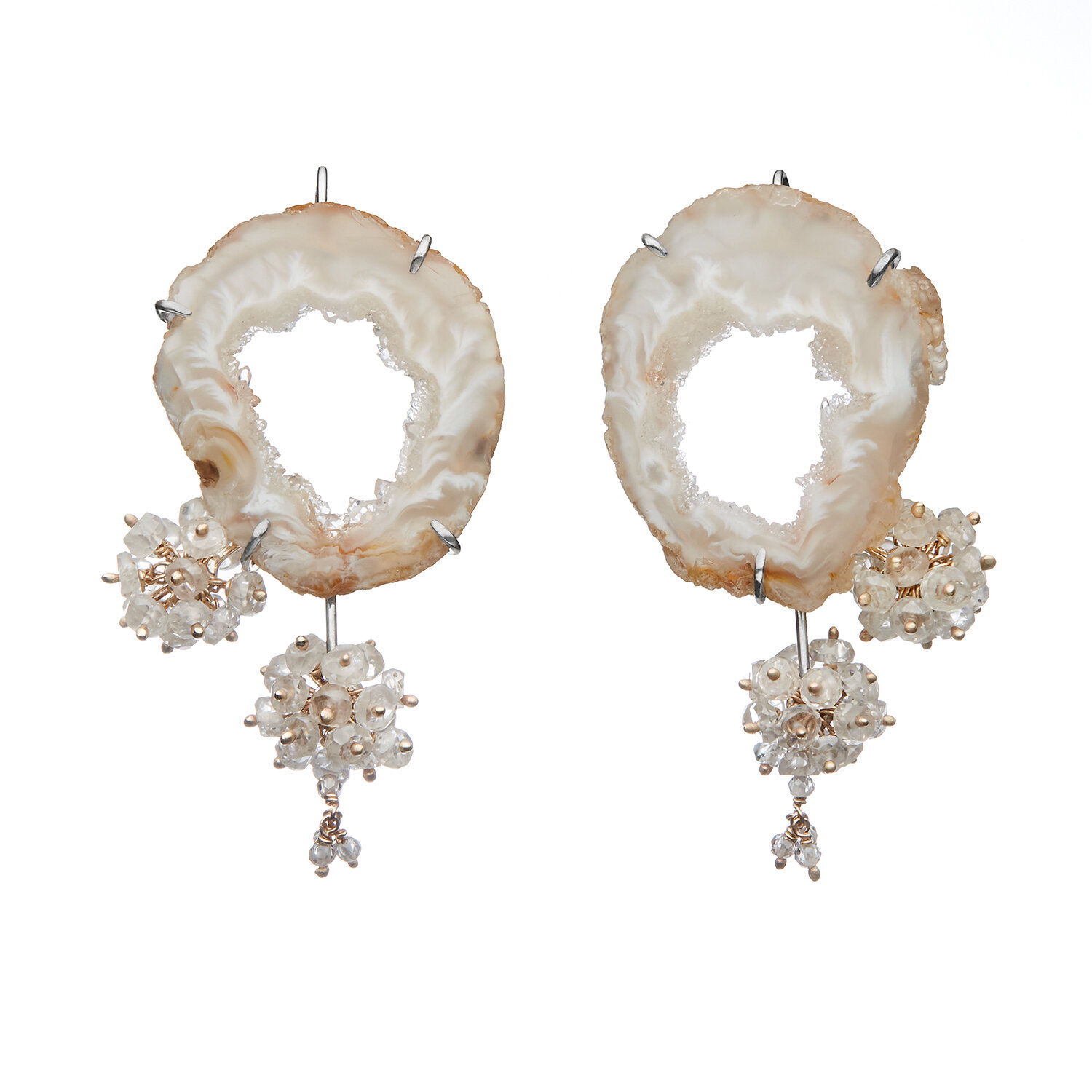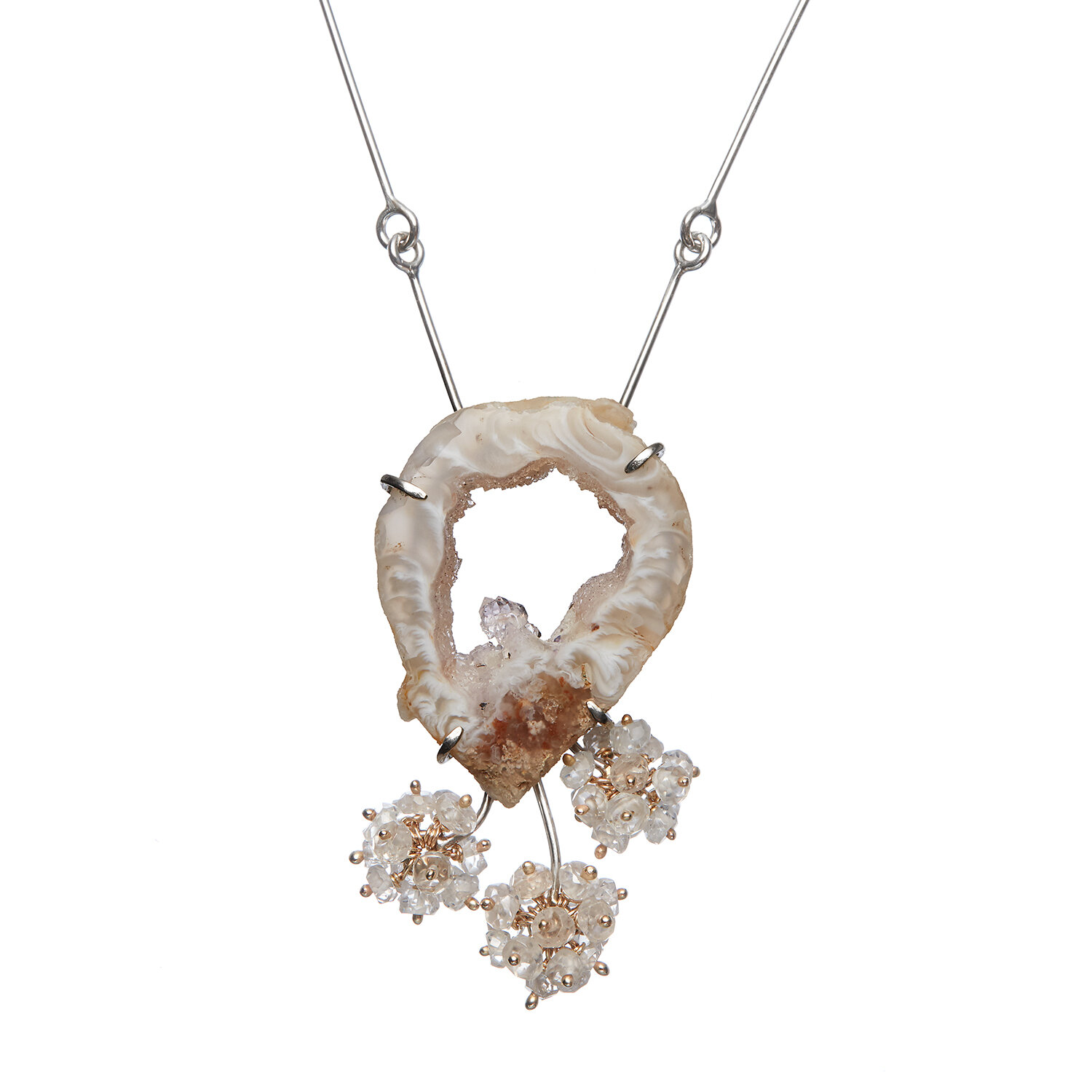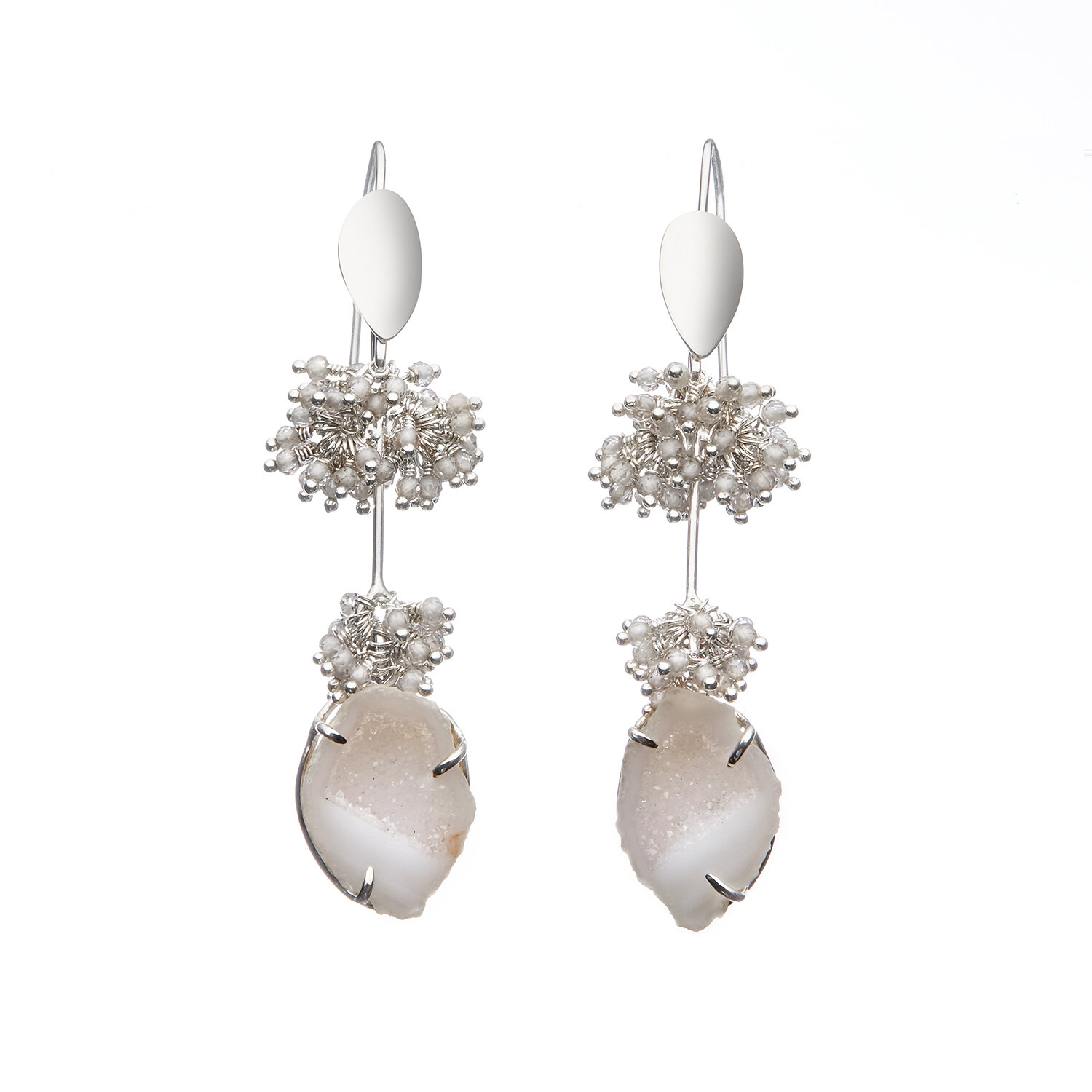Sylphide: Jewels Inspired by Starlight on Snow
Michelle Pajak-Reynolds’s one-of-a-kind ‘Zephire” earrings and pendant necklace from her “Sylphide” collection featuring 3.25 carats (total weight) pin-set raw diamond clusters and Brazilian Oco geode slices prong set in handcrafted recycled sterling silver open-back frames.
Inspired by the legend of Marie Taglioni—the Romantic era’s ethereal prima ballerina—Sylphide captures the enchantment of dancing beneath a winter sky. Mysterious geodes, shimmering sillimanite, and clusters of raw diamonds and champagne zircons evoke the sparkle of starlight scattered over untouched snow. Each design is graceful, contemporary, and unapologetically one-of-a-kind—a wearable vignette of a magical moment that has lived on for nearly two centuries.
Spark of Inspiration
The story began unexpectedly. In early 2018, while immersed in my Voyageuse collection—a study in mossy greens and botanical forms—Pinterest’s algorithm delivered an image that stopped me cold: Necklace for Marie Taglioni by the late, great British artist Wendy Ramshaw. Ramshaw’s jewel was itself a tribute to an earlier creation—Joseph Cornell’s 1940 assemblage Taglioni’s Jewel Casket, a poetic work honoring the enduring legend of Marie’s snowy-night performance in Russia. I had long admired Ramshaw’s Picasso’s Ladies series, where she reimagined jewels for women immortalized by the artist’s brush. This new discovery felt like a signpost pointing toward a story I needed to tell in my own medium.
The Ballerina Who Changed Everything
Marie Taglioni (1804–1884) transformed ballet forever. The first female dancer to perform en pointe, she introduced a new lyrical style that made her appear weightless—soft arms, tilted torso, effortless elevation—all while concealing the spinal curvature she had from birth.
In 1832, her father, choreographer Filippo Taglioni, created La Sylphide for her. The mid-calf bell skirt, pink tights, and gossamer wings she wore caused a scandal—ankles on display!—but also became the defining silhouette of Romantic ballet. Her portrayal ignited what became known as “the cult of the ballerina.” Audiences were enthralled—women copied her hairstyles, little girls cherished La Sylphide dolls, and even the Queen of England was said to own one. Cakes, confections, and trinkets bearing her likeness became coveted tokens of devotion.
That same year, she married Comte Auguste Gilbert de Voisins. Unlike many women—and especially ballerinas—of her era, she did not step away from the stage after marriage or motherhood. But behind the graceful public image, her personal life was less harmonious. She separated from her husband in 1836 and, according to biographers, later formed a relationship with long-time admirer Eugène Desmares, who famously defended her honor in a duel. Her life, like her dancing, was layered with romance, intrigue, and whispers of scandal.
A Night of Starlight and Snow
When one of Marie’s rivals, Viennese dancer Fanny Elssler, joined the Paris Opera, the Taglionis accepted an engagement with the Russian Imperial Theatre so Marie wouldn’t have to share the spotlight. In the winter of 1835, while traveling through Russia, she was confronted by a highwayman. To distract him and protect her jewels, she danced under the stars on top of an animal skin laid across a snow-covered road. The performance became legend. Some say she kept a piece of faux ice in her jewelry box for the rest of her life, a frozen keepsake of that night’s beauty and danger.
When I first read this, my jeweler’s mind sparked with a single thought: What else was in her jewelry box?
Marie Taglioni dancing the title role in La Sylphide. Her costume, including a formfitting bodice, shortened skirts, and gossamer wings is the iconic look of Romantic Period ballets. Artist unknown, Image credit Wikipedia
Finding the Starlight
Faceted diamonds felt too predictable. Pearls, too familiar. I wanted gems with an unconventional brilliance—stones that shimmered with the elusive light of stars on snow. My search began at the AGTA Show in Las Vegas, where I combed through miles of booths until I discovered them: petite geodes in blush and silvery white, their glittering interiors no larger than a fingertip. They were perfect—rare, delicate, and filled with the quiet magic I had been chasing. Rose-cut sillimanite cabochons, with their silky luminescence, joined the palette, along with swirling geode slices in pale pink and deep champagne gold. Light champagne zircons brought an extra dimension of sparkle, while bright-finished recycled sterling silver and warm Fairmined 14k gold became the architectural framework.
Detail view of half of a petite Tabasco geode pair used in jewelry artist Michelle Pajak-Reynolds’s Sylphide Collection. Photo credit: Michelle Pajak-Reynolds
The Art of Weightlessness
In the studio, my challenge was to translate the poise of a ballerina into metal and stone. I sketched hundreds of concepts, built dozens of prototypes, and refined each piece until it carried the lightness I envisioned.
I used open-back prong and bezel settings—hand-fabricated to match the unique contours of each gem—so light could flow through, illuminating the stones from within. Every setting took hours of meticulous work, a quiet dialogue between my hands and the materials.
A Collection with a Name, Not a Number
Each Sylphide design carries the name of a Romantic-era ballet—some danced by Marie herself, like Flora and Helena, others inspired by her artistry, such as her sole choreographic work, La Papillon. These are not just jewels. They are tiny stages, each one holding a performance frozen in precious metal and stone—a whisper of starlight, a trace of snow, and the immortal grace of a ballerina who once danced her way into legend.



